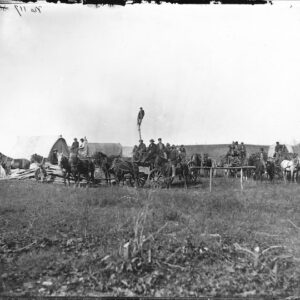| Credit: | by OSullivan (Timothy H.) |
|---|---|
| Date: | 1864.04 |
| Negative Size: | 8 in. x 10 in. |
| Equipment: | shovel; Sibley tent; telegraph pole; telegraph wire; wall tent |
| Locations & Lines: | Brandy Station VA; Virginia |
| Military Units: | Army of the Potomac; US Army; US Military Telegraph Corps |
| Transports: | freight wagon |
| Sources: | Library of Congress; National Archives |
$6.99
File Details: AILQm, 800 DPI, TIFF, Original Photograph, 40.4 Mb
Image ID: AILQ
Gardners Photographic Sketch Book Of The War. Vol. 2, No. 62. U. S. Military Telegraph Construction Corps. April, 1864. This sketch represents the Telegraph Construction Corps of the Army of the Potomac putting up the wire. The Corps was composed of about one hundred and fifty men, with a requisite number of wagons, pack mules, &c. A squad of these men was assigned to each Corps Headquarters, and was always in readiness to put up new lines or remove those already up at a moments notice from the Commanding General. During the first two years of the war the common wire was used; but as is referred to elsewhere, when Grant set out in his Wilderness Campaign, a flexible insulated wire was substituted. The large wire was wound on reels and placed in wagons, which drove along the route where the line was to be erected, the men following and putting up the wire as it unreeled. The work was done with great rapidity, and seldom became disarranged. The first lines were used when McClellan was organizing the Army at Arlington. On the Peninsula the telegraph followed the troops in all directions, and during the Fredericksburg and Chancellorsville Campaigns proved an unfailing means of communication between the Army and Washington. As it was only intended for temporary use, the poles were not required to be very substantial, and could be always found in that wooded country near any proposed route. The immense labor required in the construction of this telegraph led to the adoption of the insulated wire, which could be used with very little trouble. A coil of the latter would be placed on the mules back, and the animal led straight forward without halting while the wire unreeled, it only being necessary for two men to follow and hang up the line on the fences and bushes, where it would not be run over. When the telegraph extended through a section unoccupied by our troops, cavalry patrols watched it, and by holding the inhabitants responsible for its safety, generally prevented any interference with the line. The Central Telegraph Office was in the War Department building, from which a network of wires radiated in every direction. President Lincoln frequently visited this office, and spent many an evening sitting at the instruments reading the reports as they came in and were recorded by the operators.
National Archives says: Virginia, Brandy Station, Telegraph Construction Corps of the Army of the Potomac.
Library of Congress says: Military telegraph construction corps


